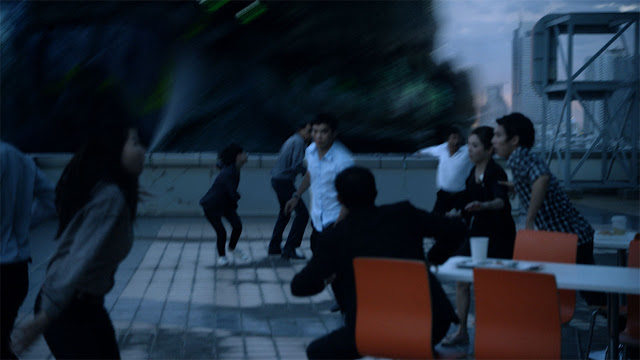In Del Toro's film Pacific Rim, parts of Manila was destroyed by a giant amphibious beast called Kaiju. It was the second appearance of a Kaiju on Earth after the Trespasser ruined much of San Francisco. Canon literature about the attack on Manila has yet to be written, so there is much room for speculation.
Given this trickle of information (and that the Kaiju was apparently nuked), movie goers have raised some interesting questions as to how the beast got into in the city.
Here are some geographical facts about Manila:
- Manila lies in the West Philippine Sea. To reach Manila Bay, a Kaiju has to swim around the northern tip of Luzon or pass through the waters off Bicol and Quezon.
- The islands of Corregidor and Caballo cuts the entrance to the bay into two narrow channels. A Kaiju, because of its huge size and water displacement will be spotted when it emerges in these waters.
- East of Manila is the Sierra Madre. The mountain range runs from north to south of Luzon, starting in Cagayan and ends in Quezon. Some peaks along the range reaches up to 6000 feet.
Since the Breach is located beneath the Pacific Ocean, some observers on Twitter speculate that the Kaiju will most likely appear somewhere in the east, probably in Quezon Province and lumber all the way to Manila. In 2014, the Philippine Armed Forces don't have fighter planes, warships or even tanks to take down the beast. Its soldiers however, have weapons to delay the monster's advances. In such scenario, complete evacuation of the city might be possible and casualties are minimized. But evidence seen in the movie trailer suggests it didn't happen in the back story.
A convincing tale is that a Kaiju emerges in Manila Bay, sending a shocked metropolis into fits of frenzy. Images of a flattened San Francisco, with the US forces helpless to stop the beast is still fresh in their memory. The howls of the Trespasser, heard on television screens are stuff of nightmare driving people out of their beds. And now reappears the beast - a different and more sinister one - this time pummeling their city.
Thousands will die, not from being trampled by the Kaiju. But from stampedes caused by mobs trying to escape. Their panicked screams alone will leave the weak and weary frozen in their spot. The injured and the dying will have no place to go. Not even hospitals are spared from the Kaiju's unpredictable path. Traffic gridlock will render major roads useless, while trains would be forced to ease operations because of the tremors caused by the beast's heavy footsteps.
Thousands will die, not from being trampled by the Kaiju. But from stampedes caused by mobs trying to escape. Their panicked screams alone will leave the weak and weary frozen in their spot. The injured and the dying will have no place to go. Not even hospitals are spared from the Kaiju's unpredictable path. Traffic gridlock will render major roads useless, while trains would be forced to ease operations because of the tremors caused by the beast's heavy footsteps.
 |
| Remnants of the Beast |
Seeing the hopelessness and suffering, the Philippine government has no choice but to beg military aid. The US being its strongest ally would hesitate sacrificing its battered forces. They fear another Kaiju attack anytime on the mainland. Regional powers would send a few squadrons, but these token fighters will be decimated without ever injuring the beast.
By now, doomsayers and some experts believe the Kaiju attacks will continue.
It will be each country for itself.
If not for a global call to save Manila, the world's most powerful nation would not act to kill the beast. The solution applied will be the same as the one they did in San Francisco a year earlier. An Ohio-class submarine deployed from Okinawa sails toward Bataan. In its payload is the most destructive weapon known to man. With no choice and with millions of displaced lives at stake (as no other means to kill the beast exist yet), the broken leaders of the Philippine government brook no opposition. The launch codes were given and entered into the computer. A lone ICBM lifts off from the hatchet and directed at the beast who seemed invisible to conventional attacks.
A flash of light, a thunderous clap and a mushroom cloud inside its belly, the Kaiju, at long last is dead.
By now, doomsayers and some experts believe the Kaiju attacks will continue.
It will be each country for itself.
If not for a global call to save Manila, the world's most powerful nation would not act to kill the beast. The solution applied will be the same as the one they did in San Francisco a year earlier. An Ohio-class submarine deployed from Okinawa sails toward Bataan. In its payload is the most destructive weapon known to man. With no choice and with millions of displaced lives at stake (as no other means to kill the beast exist yet), the broken leaders of the Philippine government brook no opposition. The launch codes were given and entered into the computer. A lone ICBM lifts off from the hatchet and directed at the beast who seemed invisible to conventional attacks.
 |
| Life After the Attack |
A flash of light, a thunderous clap and a mushroom cloud inside its belly, the Kaiju, at long last is dead.

No comments:
Post a Comment